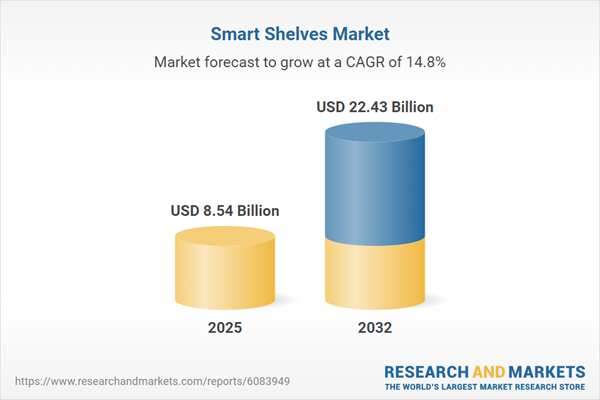Speak directly to the analyst to clarify any post sales queries you may have.
The smart shelves market is rapidly reshaping retail and enterprise environments by merging data-driven intelligence with physical store infrastructures, delivering a new standard in operational efficiency and customer engagement.
Market Snapshot: Smart Shelves Market Size and Growth Trend
The smart shelves market advanced from USD 7.42 billion in 2024 to USD 8.54 billion in 2025, and is forecast to maintain robust expansion at a CAGR of 14.82%, reaching USD 22.43 billion by 2032. Escalating demand for real-time inventory management and predictive analytics solutions is catalyzing the global adoption of these intelligent shelving systems. Organizations in retail, healthcare, and industrial sectors are embracing these technologies to drive operational transformation, while investments from technology providers and integrators are reinforcing the market’s long-term growth trajectory. Enhanced retail experiences and seamless digital-physical integration continue to be central drivers, further establishing the smart shelves market as a strategic focus within modern enterprise environments.
Scope & Segmentation
This report delivers comprehensive insight into the smart shelves industry, detailing market segmentation by technology, user application, and global region:
- Component Types: Includes displays, proximity sensors, weight sensors, shelf indicators, analytics software, platforms for real-time monitoring, management software, and a range of services such as installation, integration, and maintenance. Each type underpins smart shelf functionality by supporting inventory accuracy, data flow, and seamless hardware-software interaction.
- Shelf Formats: Features autonomous shelves, cart-based units, fixed shelves, and mobile systems. These formats target distinctive merchandising and operational needs present in enterprise and retail settings, from high-traffic outlets to complex distribution nodes.
- Connectivity Technologies: Comprises AI vision systems, high-resolution cameras (2D and 3D), barcode scanners, and RFID tools. Such technologies facilitate flexible and accurate data capture, bridging digital infrastructure with physical inventory in real time.
- End-Use Applications: Spans healthcare (hospitals, pharmacies), industrial environments (factories, logistics centers), and retail (grocery, apparel, e-commerce). Use cases range from medication tracking to streamlined stock management and consumer personalization at the shelf-edge.
- End Users: Encompasses healthcare providers, specialty retailers, franchises, supermarkets, cold storage operators, and distribution centers. Each pursues distinct deployment models, influencing system selection and required service levels.
- Regional Coverage: Markets comprise the Americas (including United States, Canada, Mexico, Brazil, Argentina, Chile, Colombia, Peru), Europe, Middle East & Africa (such as UK, Germany, France, Italy, Spain, Sweden, UAE, Turkey, Israel, South Africa, Nigeria, Kenya), and Asia-Pacific (including China, India, Japan, Australia, South Korea, Singapore, Taiwan).
- Key Companies: Major participants include Avery Dennison Corporation, HY-LINE Holding, Keonn Technologies, RAINUS, Samsung Electronics, NXP Semiconductors, Huawei, Honeywell International, Intel Corporation, and Mago S.A.
Key Takeaways: Strategic Insights for Decision-Makers
- Deployment of intelligent shelf systems enables continuous inventory tracking and proactive stock replenishment, reducing out-of-stock events and curbing operational expenses due to manual errors.
- Analytics software, linked with advanced sensor hardware, transforms omnichannel data into strategic actions, strengthening the connection between digital engagement and in-store experience.
- Emergent AI-powered vision and edge computing solutions are setting new standards for inventory accuracy, boosting both agility and data reliability for operators managing complex portfolios.
- Each vertical—healthcare, industrial, and retail—demands industry-specific features, as regulatory mandates and operational workflows drive variability in technology adoption and compliance practices.
- Strategic partnerships among retailers, technology providers, and hardware suppliers are accelerating development cycles, supporting scalable integrations and rapid return on investment.
- Investments in modular platforms and selective industry consolidations are positioning major players for long-term competitiveness amid shifting market landscapes and evolving service models.
Tariff Impact: Navigating Regulatory Change
The 2025 introduction of new United States tariffs on crucial electronic components—including displays, sensor modules, and circuit boards—has heightened production cost pressures for smart shelves suppliers. In response, manufacturers are expanding supplier networks and evaluating nearshoring strategies to sustain supply chain agility. By establishing regional assembly hubs and offering bundled services, organizations can reduce risk exposure and maintain market responsiveness. Collaboration across industry stakeholders is essential for supporting ongoing innovation and supply chain flexibility under changing regulatory conditions.
Methodology & Data Sources
Research for this report was based on a mixed-method approach, combining executive interviews and surveys with service providers, along with in-depth secondary research that encompassed industry publications, regulatory filings, and patent analysis. Data triangulation and validation practices ensure decision-grade accuracy and actionable recommendations for technology adoption and competitive assessment.
Why This Report Matters
- Delivers strategic, up-to-date guidance for senior leaders in retail, healthcare, and logistics seeking to optimize technology selection, deployment strategies, and vendor relationships in the evolving smart shelves market.
- Arms decision-makers with actionable perspectives to anticipate and respond to market volatility, regulatory shifts, and fast-changing regional dynamics—empowering robust competitive positioning and value creation.
Conclusion
The smart shelves market is defined by the synergy of advanced sensor hardware, connected analytics, and adaptive digital platforms, empowering businesses to streamline operations and enhance personalized experiences. Adopting these solutions supports strategic differentiation in dynamic enterprise and retail domains.
Table of Contents
3. Executive Summary
4. Market Overview
7. Cumulative Impact of Artificial Intelligence 2025
List of Figures
Companies Mentioned
The companies profiled in this Smart Shelves market report include:- Avery Dennison Corporation
- HY-LINE Holding GmbH
- Keonn Technologies, S.L.
- RAINUS Co., Ltd.
- Samsung Electronics Co., Ltd.
- NXP Semiconductors N.V.
- Huawei Technologies Co., Ltd.
- Honeywell International Inc.
- Intel Corporation
- Mago S.A.
Table Information
| Report Attribute | Details |
|---|---|
| No. of Pages | 194 |
| Published | November 2025 |
| Forecast Period | 2025 - 2032 |
| Estimated Market Value ( USD | $ 8.54 Billion |
| Forecasted Market Value ( USD | $ 22.43 Billion |
| Compound Annual Growth Rate | 14.8% |
| Regions Covered | Global |
| No. of Companies Mentioned | 11 |









